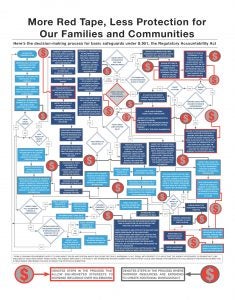By Martha Roberts
 (This post was co-authored by Tomas Carbonell)
(This post was co-authored by Tomas Carbonell)
Before he became Administrator of the Environmental Protection Agency (EPA), Scott Pruitt was relentless in suing to oppose the Clean Power Plan, America’s first-ever nationwide limits on carbon pollution from power plants.
So relentless, in fact, that as Attorney General of Oklahoma he brought suit four times to block these common sense, cost-effective protections—including litigating to block the proposal, before the Clean Power Plan was even finalized.
Given that history, you’d think that Pruitt would be eager to for the U.S. Court of Appeals for the D.C. Circuit Court to continue the current litigation over the Clean Power Plan, which Pruitt helped initiate when he was Attorney General.
Instead, the Trump Administration launched a full-court press to stop the court’s deliberations in their tracks.
The administration filed a motion on March 28 asking the court to suspend the litigation indefinitely – almost a year after the last briefs were filed in the case, and more than six months after oral argument took place before the full en banc court.
Why the sudden aversion to the court considering the case, after such a long history of litigating?
Perhaps Pruitt was afraid that the court would see the Clean Power Plan for what it is – a common sense and achievable plan, firmly grounded in the law and in science, which responds to the most urgent environmental challenge of our time.
Pruitt repeatedly argues that the reason to repeal the Clean Power Plan is because it is “illegal.” Without a D.C. Circuit opinion, all we have are his own claims on that point – and maybe Pruitt prefers it that way, given his poor record in past legal challenges to common sense EPA safeguards.
Whatever the reason, Pruitt pressed ahead to stop the very same case he was instrumental in creating. Last week, the D.C. Circuit partially granted his request. The court put the Clean Power Plan litigation on hold for 60 days, and asked for more information so it can decide how to handle the case going forward.
EPA has a duty to protect Americans from dangerous climate pollution
While last week’s order is disappointing, it has not changed the fact that EPA has a clear duty to act under our nation’s clean air laws to protect the public from harmful climate pollution. That duty is enshrined in three separate Supreme Court opinions that confirm EPA has the authority and responsibility to address climate pollution under the Clean Air Act.
EPA’s obligation to address climate pollution under the Clean Air Act is a settled question in American law. And EPA’s history of successfully addressing climate pollution from cars and other sources speaks for itself.
The Clean Power Plan itself has a rock solid legal and technical foundation – as recognized by a huge and varied coalition of supporters including former Republican EPA Administrators, the attorneys general of eighteen states, legal experts who helped draft the Clean Air Act, and the nation’s leading experts on the power grid.
As these experts recognize, the Clean Power Plan relies on strategies that are already being deployed successfully across the power sector—continuing and amplifying a transition to low- and zero-carbon energy that is reducing climate-destabilizing pollution while bringing jobs and economic opportunities to communities across the country. America’s clean energy sector is a rapidly growing $200-billion industry that employs 3.3 million Americans.
Regardless of any legal maneuvers, the fundamental truth remains – EPA has a duty to act to protect the public from dangerous climate pollution. Given the clear and present threat that climate change poses to the well-being of communities across America, this duty is urgent.


Read more



 California is a leader, and has earned that title – it is the
California is a leader, and has earned that title – it is the 
